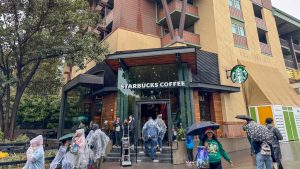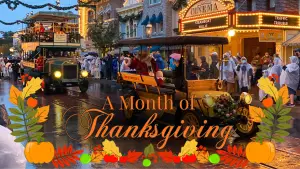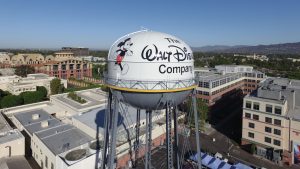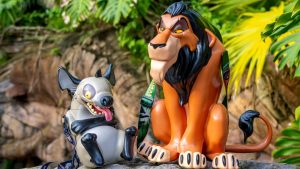One of the tangible things I miss from 30 years ago at Disneyland is their over-the-top souvenir guide. Starting in 1955, with a modest flyer printed in two colors (black and turquoise), guests were always provided with basic information to make their visit “more enjoyable.” By 1992, that single sheet had grown into a 32-page full-color booklet.

This is, as far as I am concerned, the most beautiful cover image Disney ever created for their souvenir guide. Fantasmic! may have been their big promotion that year, but this cover is all about the drama and excitement that is a flood-lit Sleeping Beauty Castle. The only hint at what lies inside is the alluring phrase, “As Night Falls Imagination Rises…”

Upon opening the guide, one found an illustration of flames meeting thunderbolt, with this title: “Brace Yourself For The Journey Into Fright And Fantasy…”
Worth noting is the Table of contents at the bottom of the inside front cover. That’s right, there was a table of contents for the souvenir guide. It should also be noted that the American Express sponsor’s logo on this page was the second to be seen in this document. Kodak took pride of place at the bottom of the first page.
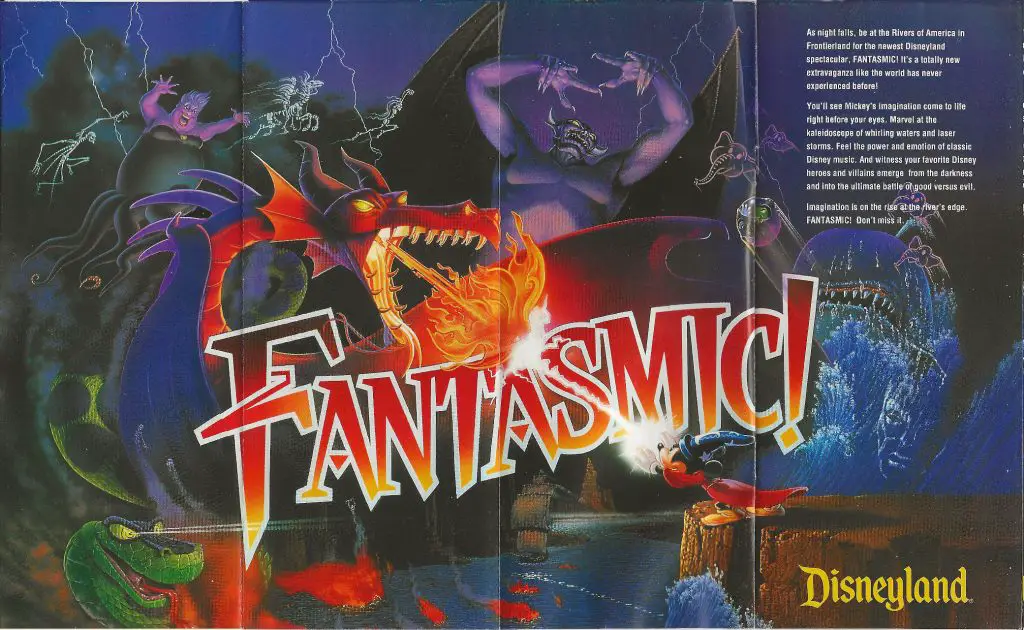
Opening the next page revealed this guide’s outstanding feature— a four-page fold-out. Clearly, Fantasmic! was just too big to be contained on the cover alone. No, it needed an extravagant horizontal splash panel to fully express its excitement
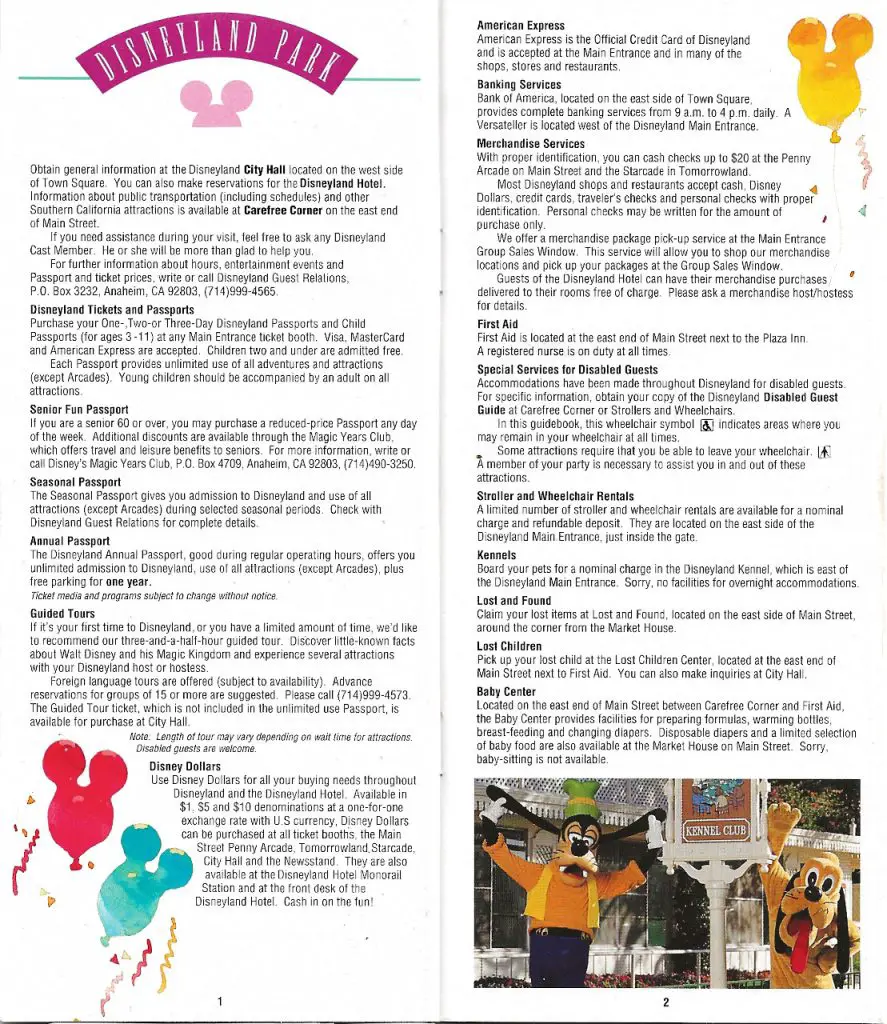
After all that excitement, it was almost a relief to find the next pages crowded with densely packed general information about your visit to Disneyland Park. Since there were no apps around in 1992, these pages were filled with fascinating tidbits about topics as diverse as the Senior Fun Passport (available through the Magic Years Club), Banking Services (at the Bank of America on Town Square, or the conveniently placed Versateller), two hour photo processing (courtesy not of Kodak, but rather Fox Photo), and Disney Dollars (“Cash in on the fun!”).
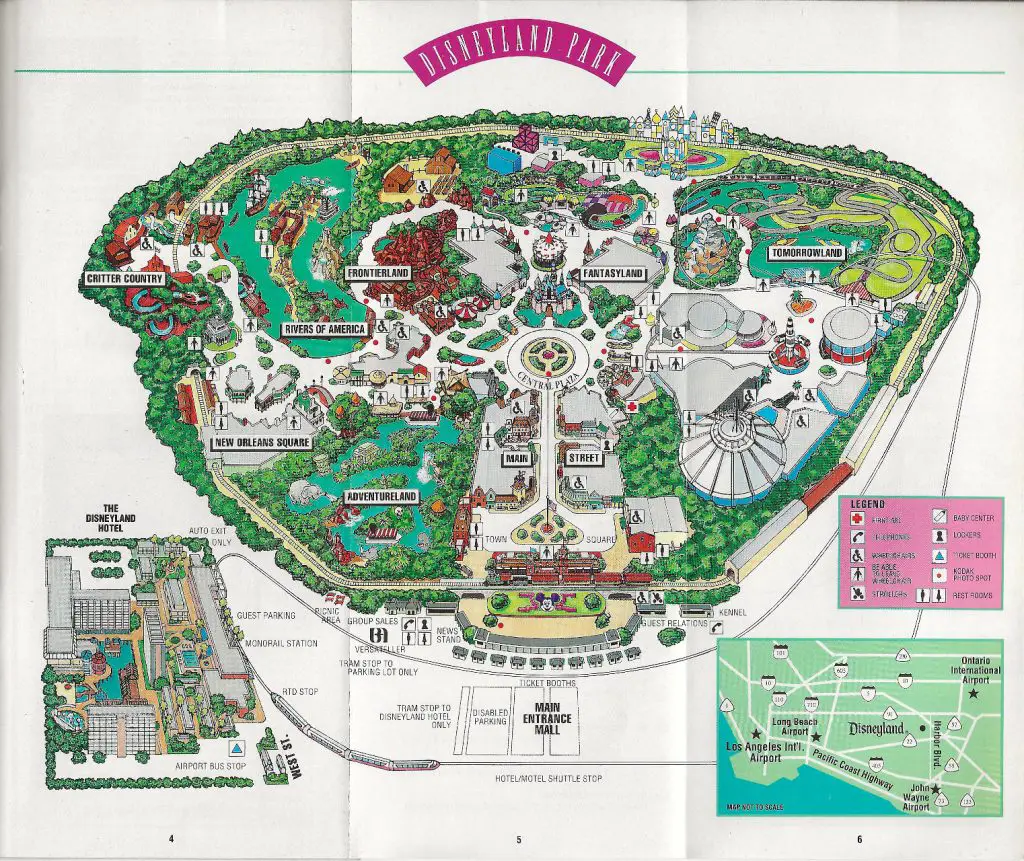
Our next foldout is almost as exciting as the one on the inside front cover. This one, covering three pages, was the full park map, with a key to all lands and services. There was also a helpful illustration of the Disneyland Hotel and a thumbnail map of local freeways.
Following the general map were pages devoted to each of the seven “lands” of Disneyland. Each was given a two page spread, with the exception of Main Street, USA.
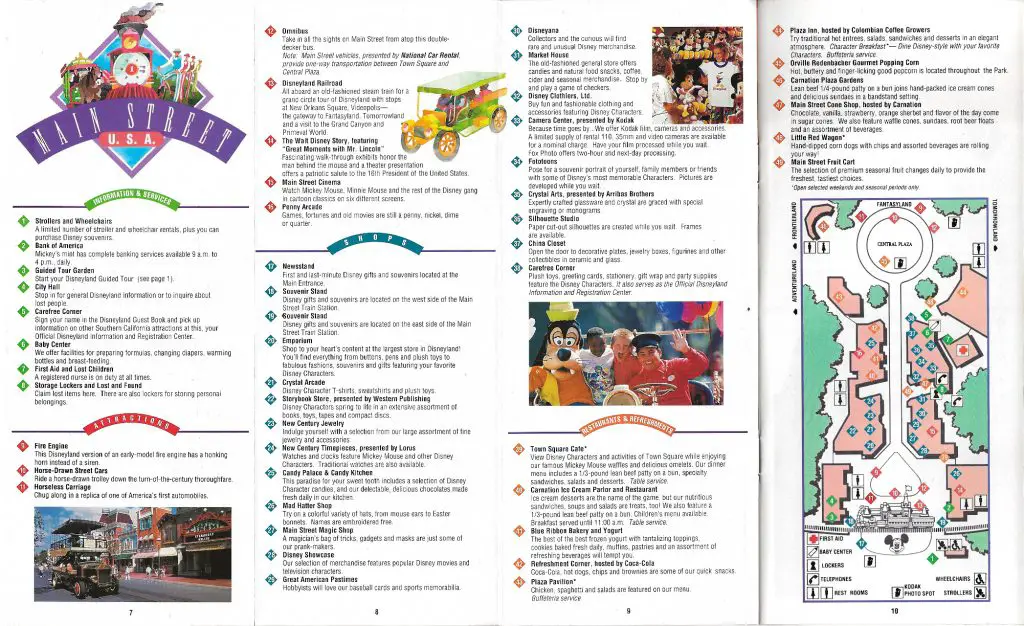
Main Street was so densely packed with features that it required four full pages to describe all of its services, attractions, shops, and dining options. No less than eleven restaurant and refreshment locations were described, ranging from the Town Square Cafe to the Main Street Fruit Cart. Still holding forth from Disneyland’s earliest days were the Carnation Ice Cream Parlor and Restaurant, the Plaza Inn, Coca-Cola’s Refreshment Corner, Plaza Inn, and the Carnation Plaza Gardens (burgers, hand-packed ice cream cones, and sundaes in “a bandstand setting”).
Among the newer shops, the Great American Pastimes offered baseball cards and sports memorabilia, while Disneyana offered rare original and vintage Disney items. In the Camera Corner, presented by Kodak, guests could pose for “Fototoons,” souvenir portraits that incorporated Disney characters. Carefree Corner, in addition to offering greeting cards, gift wrap, and stationery also served as the Official Disneyland Information and Registration Center. Go inside and register in the booklet from your home state, and see if anyone else from your hometown was there that day.
It would be wrong, of course, to spend the entire day browsing the shops and attractions of Main Street. At the end of the street was the central plaza, and all the cardinal realms of Disneyland.

To the immediate west was the alluring entrance of Adventureland. After the bewildering array offered at Main Street, this was more manageable: four shops, three dining options, and three attractions. But what options were available! The Tahitian Terrace was still offering table service, and the main attraction was the world famous Jungle Cruise.
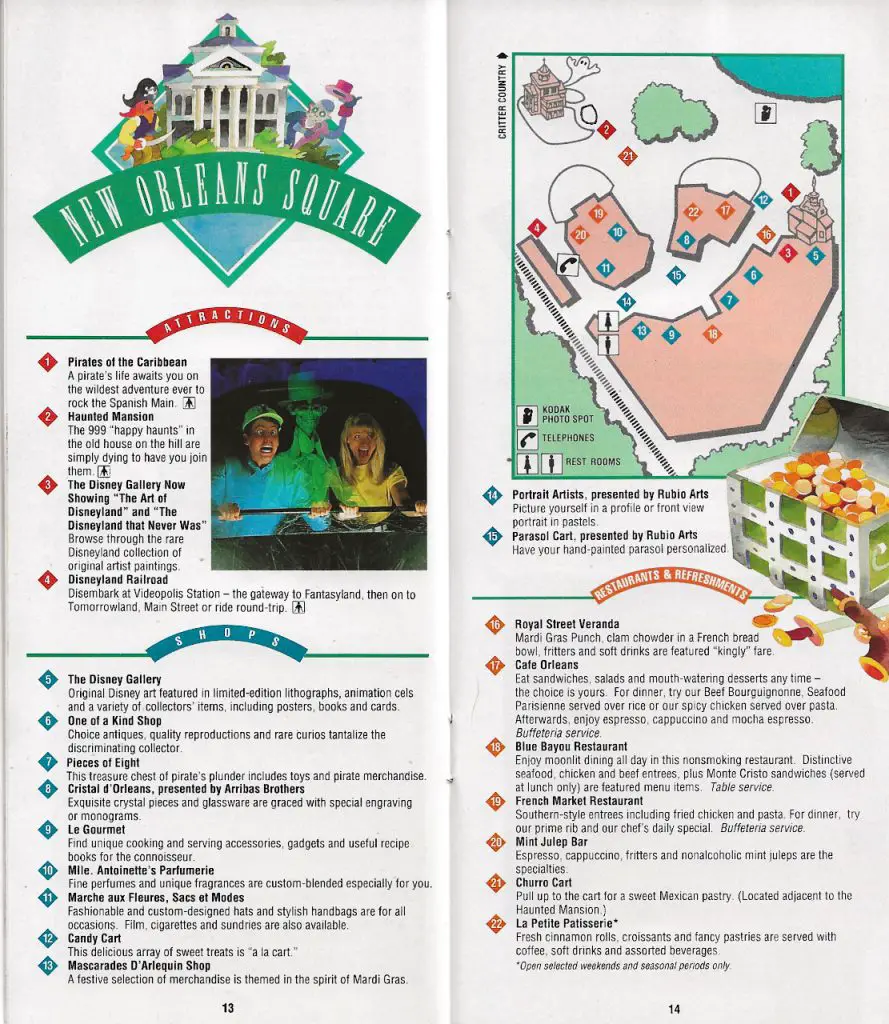
Up next was New Orleans Square. Here, dining options ranged from La Petite Patisserie to the stately Blue Bayou. Some of the park’s finest shops could be found here, including the One of a Kind Shop, stuffed to the rafters with actual antiques and rarities, all for sale. And, of course, New Orleans Square was home to both Pirates of the Caribbean and the Haunted Mansion. Joining these attractions in 1992 was The Disney Gallery Now Showing “The Art of Disneyland” and “The Disneyland That Never Was.” (That really was its full name!)
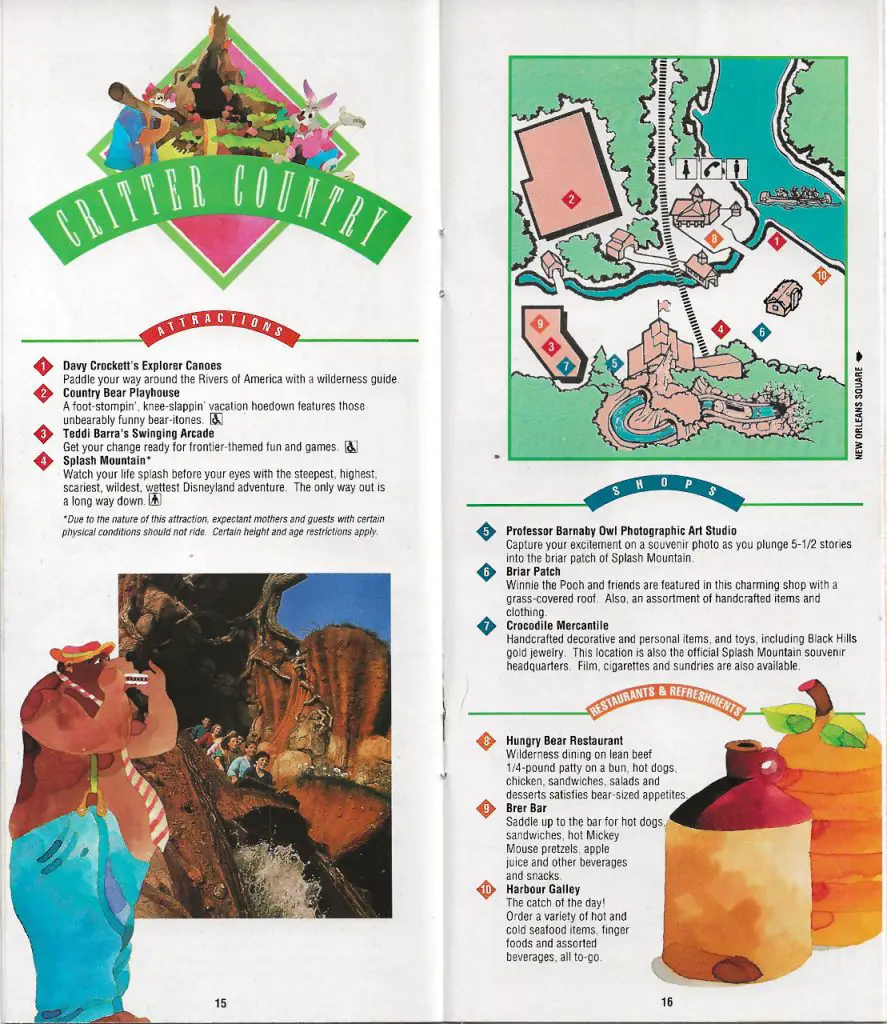
In 1992, Critter Country was the newest land in Disneyland. Added in 1972 as “Bear Country,” the land was christened anew in 1989 with the addition of Splash Mountain, and its gallery of colorful “critters.” Splash Mountain joined the Country Bear Playhouse, Davy Crockett’s Explorer Canoes, and Teddi Barra’s Swingin’ Arcade to make a total of four attractions. Three shops (including Professor Barnaby Owl Photographic Art Studio) and three food locations rounded out Critter Country.

By virtue of the inclusion of the Rivers of America and Big Thunder Mountain, Frontierland occupied the largest footprint in Disneyland. In that space could be found nine attractions, eight dining options, and five shops. Here one of the park’s oldest attractions, the Mark Twain Steamboat, was joined by the newest, Fantasmic! Guests could still enjoy the Mike Fink Keelboats and the Golden Horseshoe Jamboree (presented by Wonder Bread). Diners could enjoy the Casa Mexican, Big Thunder Barbecue, Tom Sawyer Island Cantina, or purchase a whole baked potato at the Wheelhouse.

No other land could rival Fantasyland for the sheer number of attractions. In 1992 there were eighteen, ranging from the Sleeping Beauty Castle walk-through to the Skyway to Tomorrowland. The “New Fantasyland” of 1983 was now nearly ten years old, and everything appeared as if it had always been there.
Among the ten shopping locations, there were some newer options: the Castle Christmas Shop, Small World Gifts, and the Disney Villains Shop. Guests could be forgiven for overlooking a rather small venue, the Kodak Kiosk, tucked into the edge of a planter along the way to Videopolis. How could they know they were picking up film, cameras, and accessories from the last remaining Disneyland “central ticket booth,” moved around the corner from the main courtyard and repurposed here as a retail location?
Unlike the attractions, Fantasyland suffered a scarcity of dining options. If you couldn’t get into the Village Haus (sponsored by Minute Maid), you could choose from the “Ice Cream Train” (a row of decorated refrigerator and freezer cases), or Yumz, the snack bar next to Videopolis.
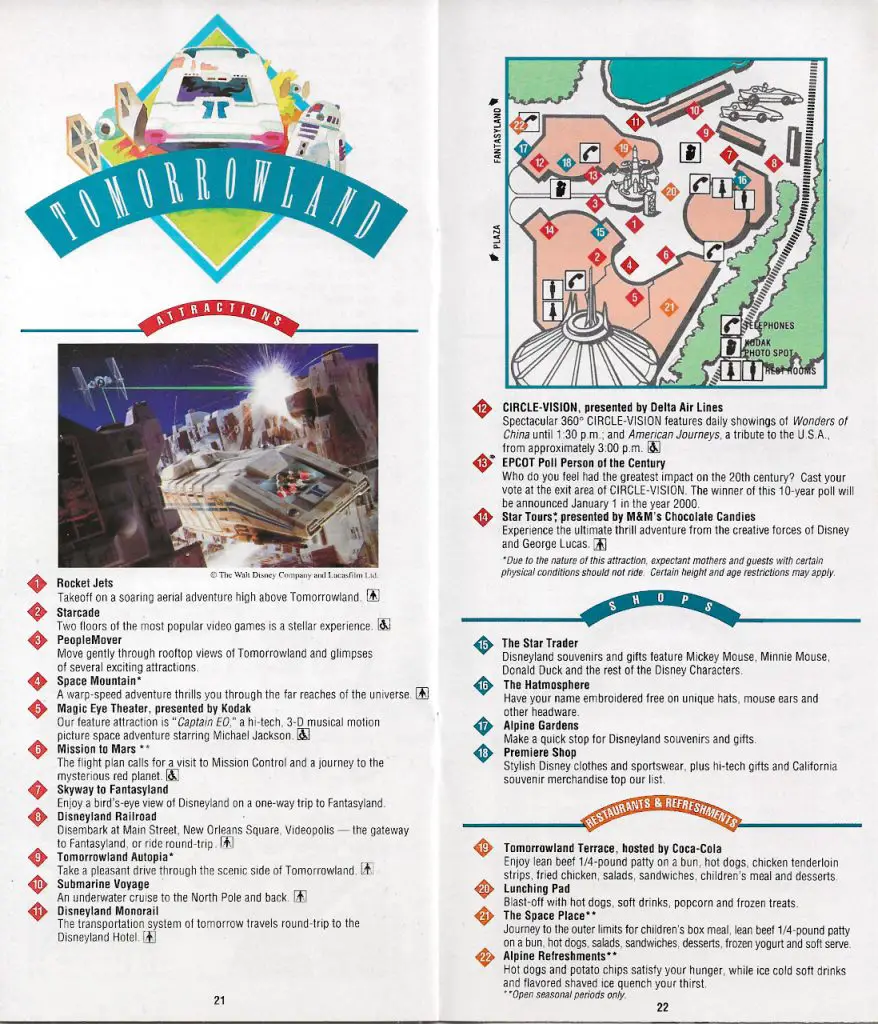
Tomorrowland was almost as large as Frontierland, and at fourteen had the second highest count for attractions. Old favorites included the Rocket Jets, PeopleMover, Submarine Voyage, and Circle-Vision (presented by Delta Air Lines). But it was newer attractions like the Magic Eye Theater (presenting Captain EO) and Star Tours that drew in the crowds.
One attraction that was rather short-lived was the EPCOT Poll Person of the Century. This could be found at the exit to Circle-Vision. This was intended to be a counterpart to the east coast version of the Poll that had been announced in 1990 for EPCOT Center at Walt Disney World. The idea was that guests would vote on the most influential person of the twentieth century over the course of ten years, and on January 1, 2000, Michael Eisner would announce the winner at a gala ceremony. However, after only a couple of years, the Poll disappeared and was never heard from again. It seems that guests (and prankish Disney cast members) discovered they could cast as many votes as they wished, and they became very creative with their choices.
Four dining locations and four shops rounded out Tomorrowland. Interestingly, both Alpine Gardens gifts and Alpine Refreshments were considered part of Tomorrowland, despite the fact that the Matterhorn Bobsleds was listed as a Fantasyland attraction.
We are now at page 23, with eight pages to go. What could possibly fill out this Souvenir Guide?
How about two pages devoted to the Disneyland Hotel?
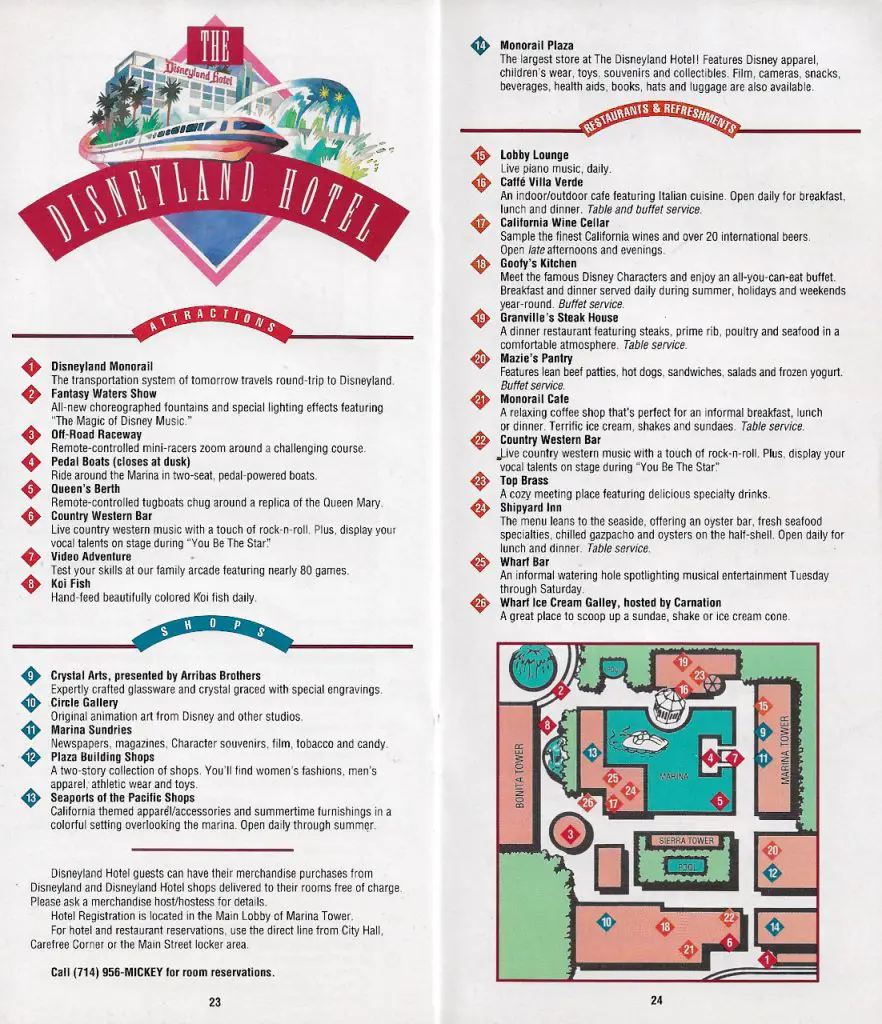
As many people may know, the Disneyland Hotel opened in late 1955 and grew along with its namesake park over the years. It was not, however, owned by Disney or Disneyland, at least until 1988. After purchasing the hotel from the Wrather Corporation, Disney added it to the Souvenir Guide and treated it almost like another land. As such, it was listed with eight attractions (ranging from the Fantasy Waters Show to Koi Fish), five shops (although two of these, the two-story Plaza Building and Seaports of the Pacific had multiple retail outlets), and no less than twelve dining locations.
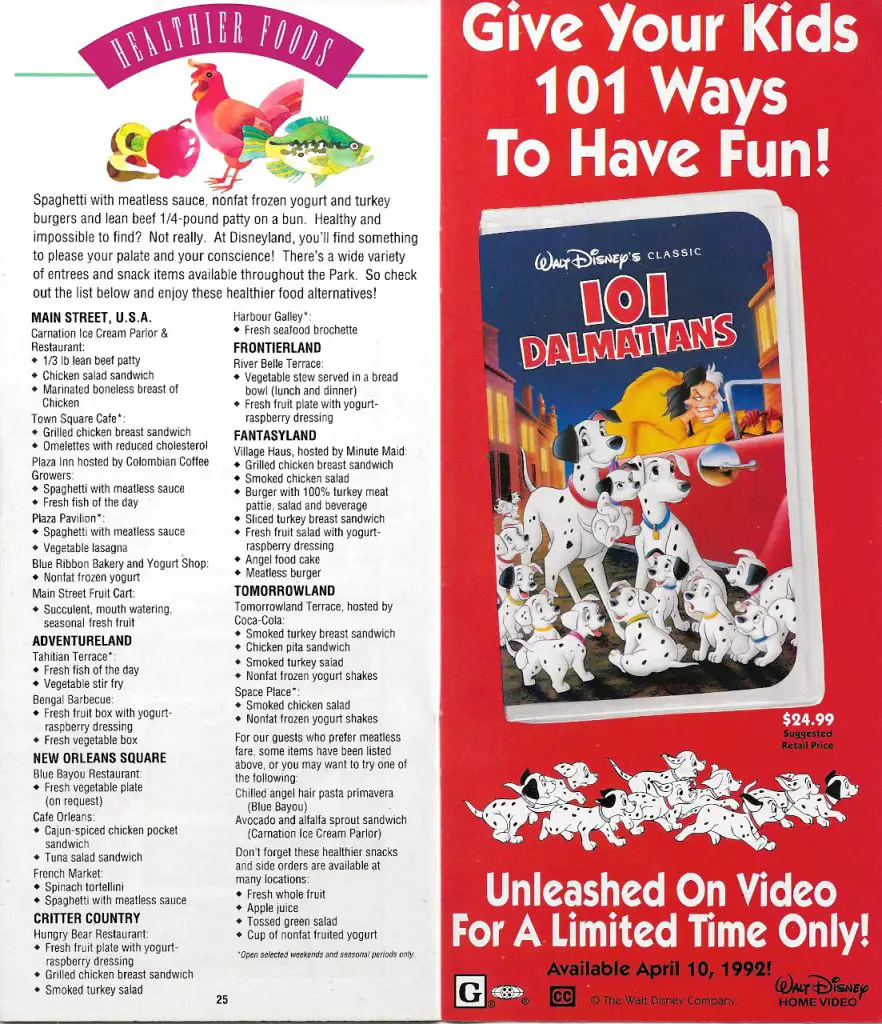
Healthier Foods is not, perhaps, the first thing that comes to mind when visiting Disneyland. But in 1992, Disney CEO Michael Eisner was determined that guests not only be aware of healthier dining options in Disney theme parks, but he also took a personal interest in the subject. And why not? This was, after all, the company executive who had catered sushi brought into a business meeting at the Golden Horseshoe. (This, where Walt himself had enjoyed hot dogs and chili.)
The healthier foods initiative was implemented everywhere in the Walt Disney Company. The list of available options in this 1992 souvenir guide includes such obvious choices as grilled chicken breast, fresh fruit, nonfat frozen yogurt, or spaghetti with meatless sauce. Perhaps a bit less popular were vegetable stew served in a bread bowl, avocado and alfalfa sprout sandwich, and meatless burger. Hands down the worst option ever offered at any Disney theme park, however, was the burger with 100% turkey meat pattie. (I found it… dry.)
Facing this list of helpful suggestions is a full-page ad for 101 Dalmatians, unleashed on video for just $24.99. Bear in mind, that once it goes back into the vault you will have to wait years to see it again.
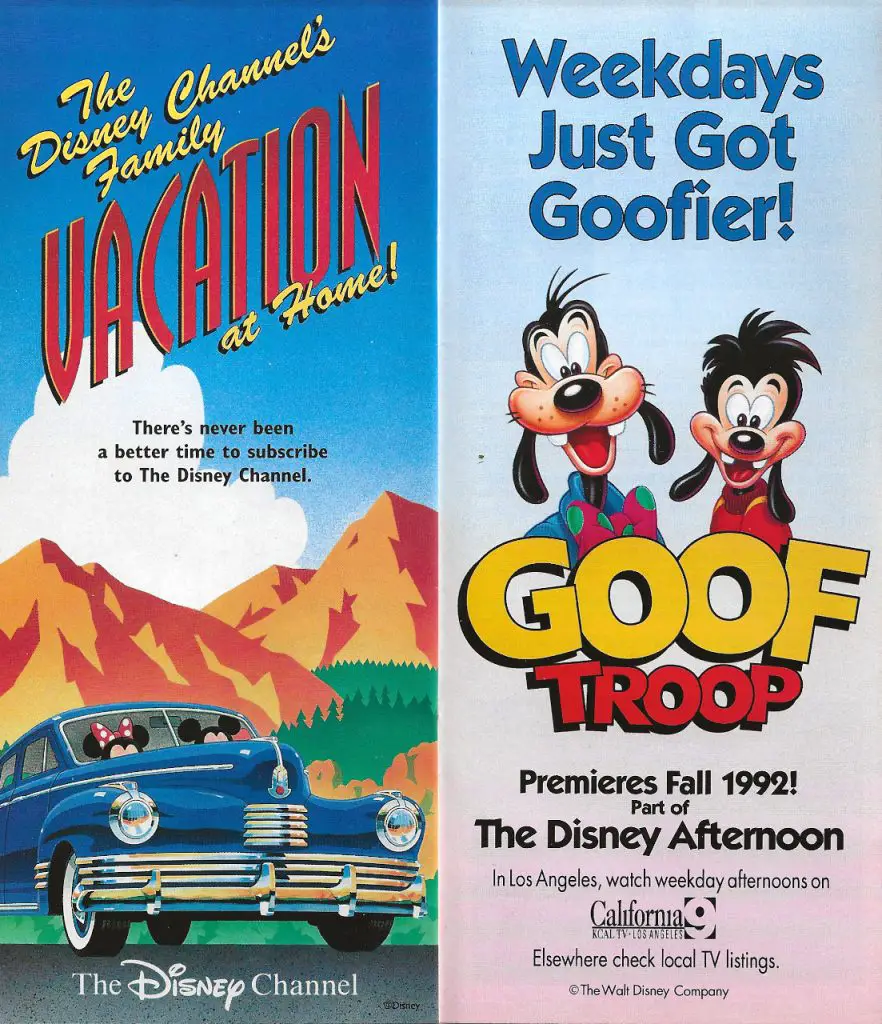
Two more pages of promotion. Or synergy. Or whatever they were calling it in 1992. Imagine people paying for the Disney Channel on cable, when they could get Goof Troop for free on KCAL 9, starting in the Fall of 1992.

Pages 29 and 30 had one of my favorite features from this era of souvenir guides. This “Treasure Chest of Trivia” was conveniently organized based on the seven lands. Did you know that 150-year-old miniature pine trees inhabit the banks of the Storybook Land Canal? (Do the math, and you will realize they are now 180 years old!)
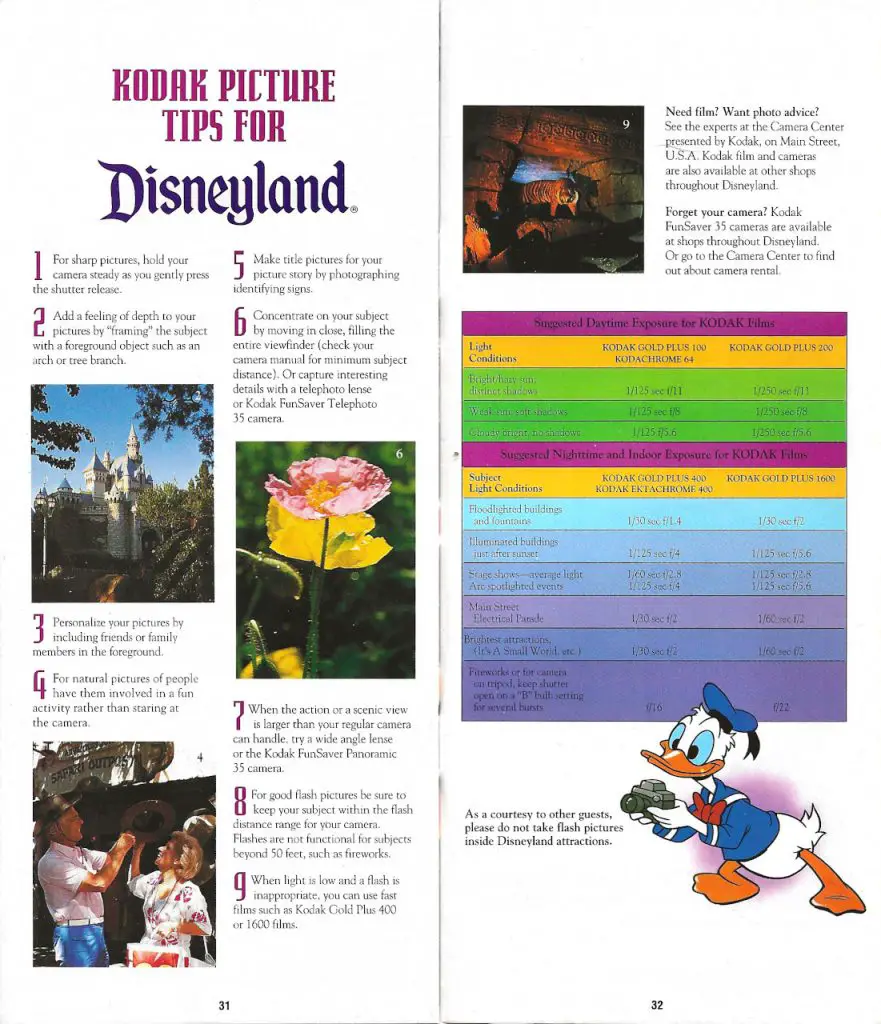
As we come to the final pages of this hefty guide, we find a two page message from our sponsor. Kodak had been a part of Disneyland from its opening day. So it was only natural that they would offer picture tips for Disneyland. Tip 4 is just as valid today as it was then: “For natural pictures of people have them involved in a fun activity rather than staring at the camera.” Who knew that Kodak was thirty years ahead of Instagram and Tik Tok?

And here we are, at the end of our journey through the 1992 Disneyland Souvenir Guide. It is fitting that we end with a sponsor’s message in the form of a full-page ad. After all, the printing of these colorful time capsules was made possible by these corporations. So the next time you visit the Happiest Place on Earth, stop by that little kiosk located in the planter opposite the small world Toy Shop, step up to the window, and silently inquire about purchasing a Kodak Fun Saver 35 Camera and a couple of rolls of film. Why trust your memories to anything less?


